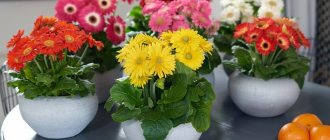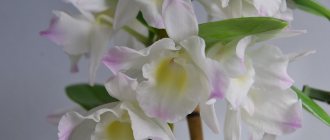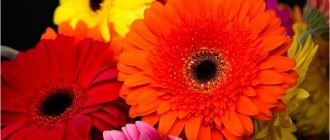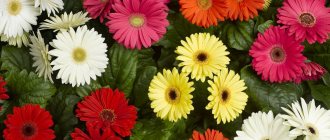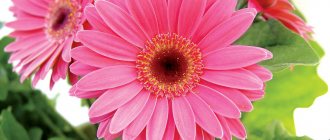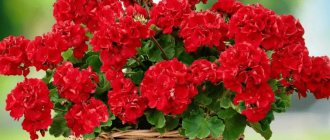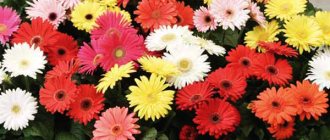If you imagine a flower arrangement in the form of a small instrumental orchestra, then with its expression and extravagance the gerbera, without a doubt, will ideally cope with the role of its first violin. It is not for nothing that florists, when creating bouquets and designers for decorating gardens, give it their preference: the dominant brightness of colors and elegant laconicism of forms are the explanation. However, the work of breeders has today allowed amateur flower growers to decorate their window sills with one of the most attractive types of flowers called Jameson's gerbera, the cultivation of which from seeds has become available indoors.
This plant belongs to the Asteraceae family. The Transvaal province in South Africa is where the Gerbera Jameson was first discovered by Europeans. Hence the second name of the wonderful flower - “Transvaal chamomile”. It was she, as a type of gerbera, that laid the foundation for many hybrid varieties cultivated indoors. On the shelves of flower shops you can often find a representative of this dwarf species in cut form as part of bouquets.
Gerbera Jameson is a herbaceous perennial. It has been grown for many years as an ornamental flowering potted plant. It has a thick stem and deeply divided juicy green leaves, collected in a basal rosette located just above the ground surface. The leaf length is from 15 to 20 cm, the surface can be smooth or pubescent. There may be cases of axillary buds forming at the base of the leaf.
In cultivation, the indoor species is represented by several hybrid varieties. Among them, the most popular is the Gerbera Jameson revolution, the photo of which did not leave indifferent the vast majority of flower growers - professionals and amateurs. The variety belongs to the ultra-early line of potted gerberas with large flowers and a dozen shades. The height of the Jemson revolution gerbera is only 10-15 centimeters, and you can admire the first inflorescences from the moment of emergence after just over 4 months.
Both double and non-double, as well as needle-shaped forms with inflorescences in the form of baskets, which are mistakenly called flowers, are cultivated. The inflorescences have amazing colors of the edge petals of a whole palette of colors: white, pink, yellow, orange, red and even red-black, collected around a yellow center. The inflorescence resembles a daisy with a diameter of approximately 10 cm, formed in the upper part of a powerful peduncle reaching 30 cm.
After the first acquaintance, it’s time to reveal the secrets of success in cultivating Jameson’s gerbera in indoor floriculture in Russia.
Planting/growing
To achieve the desired result from growing indoor gerberas - abundant, long-lasting and bright flowering - you will need to create favorable conditions and make a sufficient amount of effort. It is necessary to choose the brightest window and provide a curtain that will help protect the flower from the scorching rays of the sun. By creating optimal light and temperature conditions, providing “tasty” soil and proper watering, you can enjoy all the beauty of a blooming South African curiosity.
A little history
The first description of the gerbera genus appeared in 1737. This was done by the botanist and explorer from Holland Jan Gronovius (1690–1762). The scientist thus immortalized the name of his colleague and friend, who is known for many works in the field of botany, Traugott Gerber, a German naturalist and physician. He served for some time as director of the Aptekarsky Ogorod botanical garden in Moscow. In addition, Gerber spent a long time researching the flora of the Volga region.
But in some sources you can find another version of the origin of the name. In Latin, the word “grass” is translated as herba, which is why the flower got its name. In the UK, another name for gerbera can be found in the botanical literature - “Transvaal daisy” or “Transvaal daisy”. But be that as it may, today we will tell you about one of the most common representatives of this numerous genus - Jameson's gerbera.
Transfer
Florists advise not to rush into replanting your home gerbera soon after purchasing it. Every plant needs some period of time to adapt to new living conditions, and our flower is no exception. Replanting once a year, preferably in February, is quite acceptable in order to place the plant in a larger pot using the transfer method. The bottom of the vessel should be filled with a generous layer of drainage. Experienced flower growers chose a special pot for gerberas with a hole at the bottom for external watering. This allows you to avoid stagnation of moisture at the surface of the roots, which is detrimental to the root system.
Different plants prefer their own soil for planting, and Jameson's gerbera will be content with light, but at the same time nutritious soil. You can buy ready-made soil for roses in the store, since these flowers have similar soil requirements. If you decide to prepare the mixture with your own hands, then a recipe will do, containing equal parts of leaf and peat-containing soil, as well as coarse sand. It wouldn't hurt to add hydrogel, or at least pine bark. When planting, it is important not to bury the leaf rosette and promptly clear it of any soil that has fallen into it.
Description
Gerbera Jameson belongs to the Astrov family. The Gerber genus consists of more than seventy species of beautiful flowering plants. This flower was first discovered in South Africa by Scottish explorer Robert Jameson. And the species was named after him. Transvaal chamomile is named after its place of origin - in honor of the Transvaal province in South Africa.
Gerbera Jameson laid the foundation for many varieties and hybrids that are extremely popular among gardeners today. Large, bright and very spectacular flowers resemble chamomile in appearance, although they are much larger - they reach fifteen centimeters in diameter. Breeders today give us the opportunity to admire white, orange, pink, yellow, red, cream and other shades of flowers.
There are terry, simple, and needle varieties. In indoor floriculture, the most common low-growing varieties of Jameson's gerbera are: Gerbera Ilios, Gerbera Hummingbird and others. The flower stalks of these plants at home do not grow more than 30 cm in height. They practically do not differ from each other in appearance, and their care is the same.
Care
Since the natural habitat of the gerbera differs significantly from the conditions in the apartments of Russian lovers of growing flowers, a reasonable question arises about how to properly care for the Jameson gerbera. It becomes important to learn some secrets and tips from experienced flower growers.
The main points of care are set out in the following requirements:
- temperature - moderate, during flowering 16-20°C, in winter not lower than 12°C;
- lighting - bright diffused light, needs additional lighting in autumn and winter;
- watering - abundant all the time;
- air humidity - the leaves are not sprayed, the tray is filled with wet pebbles;
- propagation - by seeds in spring, by dividing the bush and cuttings.
Features of flowering
Gerbera Jameson has an interesting feature. For the plant to bloom profusely, it needs no more than twelve hours of bright light per day. Therefore, it blooms from early August to mid-November, when daylight becomes insufficient.
During flowering, remove faded flowers from the plant, as they can inhibit the development of new flower stalks. Another important nuance is that gerbera flowers are not cut, but broken out. The remains of the peduncle after cutting often rot and infect the entire plant with rot.
Temperature
In order for an indoor gerbera to feel comfortable and delight with abundant flowering, it is necessary to maintain its optimal temperature in the spring and summer, ranging from 20 to 25 °C. Make sure that the thermometer does not fall below +25 °C at this time.
After flowering has stopped, as well as during the dormant period, the flower is kept at approximately +14 degrees, not allowing cooling below +12 degrees.
Gerbera is sensitive to rare fluctuations in day and night temperatures at the time of flowering. If such changes occur, the inflorescences may lose their decorative effect.
Interesting facts about gerbera
The leaves and stem of gerbera contain coumarin derivatives. This substance is successfully used as a flavoring agent in the tobacco and perfume industries. In medicine, it is used to produce indirect anticoagulants. In addition, coumarin is necessary in electroplating to give products a strong shine.
A bouquet of gerberas can last in a vase for up to twenty days. But this is not the limit. If you want to preserve it even longer, then pour very little water into the vase so that the stems do not rot.
There is a legend about the gerbera, which says that once upon a time there lived a nymph with that name. Her beauty left neither women nor men indifferent. Everyone admired her, and this attention tired the nymph so much that she decided to turn into a simple wild flower. This is how the gerbera arose, which some people call a symbol of innocence and modesty.
Lighting
When choosing a place in the apartment, it is extremely important for the well-being of the gerbera to take into account the lighting requirements. While providing bright diffused light, beware of direct rays of the midday sun on south-facing windows. The optimal solution to the problem is to place a container with a flower on the windows of western or eastern exposure.
Since gerbera loves a fresh atmosphere, it will benefit from regular ventilation, but without drafts. In warm summers, the bush is taken out onto the balcony or terrace, but care is taken to ensure that ultraviolet rays do not burn the plant. The flower is gradually accustomed to a small portion of the sun. In the cold season, additional lighting is used with a fluorescent lamp.
Sowing
Gerbera seeds do not have germination properties for very long: about eight months. Therefore, you should be attentive to the date on the package, because the key to good germination is high-quality seeds.
It is customary to sow gerberas as seedlings, since they are quite demanding of external conditions and rarely survive spring cold and other inconveniences. You need to start seedlings in early spring, when daylight hours have already extended. Of course, in commercial cultivation, where single-piece greenhouses are used to create optimal growth conditions, gerberas are sown year-round.
For friendly shoots you need to take the following steps:
- Prepare a soil mixture containing sand, peat, leaf soil and perlite. Pour the soil into small containers: pots or special boxes for mini-greenhouses.
- Carefully spread the seeds onto previously loosened soil. It is better to sow thickly, every 3-4 mm, due to poor germination.
- Cover the ground with a half-centimeter layer of fertilized soil, then spray the surface with water at room temperature.
- Note: water should not clog the loosened soil, so standard watering will not work.
- The seedlings should be covered with glass or film and left in a bright, warm place out of direct sunlight. Any window sill, except the southern one, or a table near the window would be optimal.
- Seedlings develop well at room temperature (20-22˚C) provided that the soil is regularly ventilated and sprayed: it should not dry out.
You may also be interested in: Secrets of growing terry mallow from seeds
Under normal conditions, gerbera sprouts appear very quickly: within two weeks after sowing. After another 14 days, the first leaves appear.
Article about horned violet
Watering
During the growing season, gerberas are watered with well-settled water at least 2 times a week, or even more often. It is important to prevent both drying out and waterlogging of the earthen coma. There are several important nuances in watering indoor gerberas, which were shared by experienced gardeners:
- to avoid fungal disease, do not allow water to get into the leaf rosette;
- It is advisable to water into a tray using a container with a hole for external watering;
- take only warm water, and at the same temperature as the soil;
- in order to prevent stagnation of moisture, which is fraught with the appearance of root rot and the inevitable death of the flower, during the dormant period watering is provided only so that the earth ball does not dry out.
Soil preparation
Gerbera Jameson from seeds is grown in a light and loose soil mixture consisting of equal parts of peat, perlite, sand and leaf soil. You can also use a simplified version - mix peat and sand in equal proportions. The soil must be shed with a weak solution of potassium permanganate or frozen. Next, prepare a container with drainage holes. Place expanded clay on their bottom in a layer of about three centimeters and fill the container with soil mixture, lightly compacting it.
Seeds are sown superficially in moist soil, without deepening. They should be sprinkled with a thin layer of sand on top.
Flowering and dormant period
Gerbera Jameson has excessive requirements for the boundaries of the light part of the day. If you set a goal for abundant flowering, then you need to provide no more than 12 hours of bright light per day. For this reason, the plant blooms at a time when natural daylight hours are waning: from August to November. When the inflorescences fade, they are removed to stimulate the appearance and growth of young flower stalks.
At the end of flowering and until mid-February, the dormant period of gerbera comes into its own. At this time, when the plant accumulates strength for the next growing season, watering is reduced and fertilizing is stopped altogether. Make sure that the soil does not dry out, but is not over-moistened.
From the second half of February, the volume of watering is increased and mineral fertilizers begin to be applied. The potted plant is actively growing greenery and is preparing to bloom under favorable conditions. After 3-4 years, the gerbera is either rejuvenated or a new specimen is purchased.
It is possible, by depriving the plant of dormancy, to extend flowering until May thanks to additional lighting. However, such an experiment will deplete the plant and shorten its life cycle by half.
Botanical description and history
Jameson's gerbera (Gerbera jamesonii) is a perennial herbaceous plant, low-growing and compact.
Description of appearance: thickened and shortened stem, well-developed root system, drooping, deeply divided leaves (4-15 cm), at the base of which axillary buds are often present; pubescent long peduncles (25-30 cm), inflorescence - like a chamomile, a basket at the end of the peduncle (diameter approximately 10 cm). Daisy flowers come in various shades of white, yellow and red.
Historical reference. The Dutch biologist Jan Gronovirus discovered the gerbera in South Africa in 1717. The flower was named 20 years later after the German biologist Gerber. The Scottish botanist Robert Jameson studied this plant, thanks to whom such species as Gerbera Jameson and Gerbera Greenleaf appeared, which are considered the founders of all other varieties.
You can learn more about the types of gerbera existing today in this material.
Reproduction
If you were unable to purchase an adult Jameson's gerbera plant, do not despair! Reproduction is possible by seeds in spring, by dividing the bush and by cuttings. Let's take a closer look at the first method.
Seed material is purchased at a specialized store. At this point, to avoid disappointment from unfulfilled expectations, it is important to find out how fresh the seeds are and when their expiration date is. Know that the seeds of your favorite plant remain viable for no more than 8 months after collection.
You can take the risk of sowing gerbera seeds that you collected yourself or from gardeners you know. However, to obtain a positive result, the potted crop must at least be pollinated, and the seeds must be fresh for up to 3 months after ripening. However, even under favorable circumstances, you can get seedlings, but wait for a different color than your eyes predicted.
Spring is the best time for sowing, and the process consists of the following steps:
- preparing soil consisting of equal parts of peat, sand, perlite and leaf soil;
- sowing seeds in lightly compacted, moist soil;
- arrangement of a “greenhouse” with a temperature of 16-20 degrees and care: ventilation and humidification;
- emergence of seedlings on days 8-12 and opening of the greenhouse;
- picking plants with real leaves into a larger container;
- transplanting seedlings with 5-6 true leaves into separate containers as they grow.
The soil for planting young plants is prepared from a handful of perlite, 2 portions of leaf soil and 1 portion of coarse sand, peat, humus and turf.
Until flowering, teenage gerberas are placed in individual pots with a diameter of about 20 centimeters, ensuring high-quality drainage and outflow of excess moisture. The long-awaited moment of flowering of gerberas is expected in 9-11 months.
The second method of propagation is relatively simple: by dividing the bush. An adult bush is carefully split into sections with at least two or three growth points. Then the inflorescences are removed and the roots are trimmed, dusted with charcoal for disinfection. Plant each separated plant in its own pot, making sure that the growing point is just above the surface of the soil.
Propagation of gerberas by cuttings consists of separating a cutting from a mature plant with a fragment of the root system and one or two leaves. Then the cuttings are rooted, planted in moist soil, and cared for like an adult plant.
Features of plant care at home
In the future, the plant will require care consisting of simple standard procedures. It needs to be regularly watered and fed, as well as replanted.
Watering
Gerbera loves frequent, moderate watering. Droughts and waterlogging pose a danger to it. When drawing up an irrigation regime, they are guided by the condition of the soil. Moisturizing is done when its surface layer dries.
Thus, the frequency of watering will depend on lighting, air humidity, pot material and other factors. Typically, gerberas are watered 2-3 times every 7 days during the growing season and 1 time every 7-10 days during dormancy in winter.
Important! When watering, you need to make sure that moisture does not get inside the leaf rosette. This can lead to the development of fungal diseases.
It is prohibited to water a houseplant with freshly drawn tap water. It needs to be left for 1-2 days or filtered to soften and remove impurities dangerous to plants. Recommended water temperature is +20…+22°С.
Feeding
Starting from March and ending in October, the plant needs feeding. They are necessary for the flower to be healthy, bloom profusely and for a long time. For fertilizing, purchase ready-made complex fertilizers developed for indoor crops, for example, “Master”, “Agricola”, “Florovit”. When preparing them according to the instructions, you should reduce the dosage by 2-3 times. Organic fertilizers are not suitable for gerbera.
Trimming
Pruning to form a crown is not necessary for Jameson's gerbera. In spring and during flowering, you need to cut off faded buds, yellow, damaged leaves.
Transfer
It is best to replant annually in early spring. For it you need to buy a new pot, which will be 2-3 cm larger in diameter than the previous one. It is desirable that it be ceramic. Land for planting can also be purchased. Any universal soil designed for beautifully flowering indoor crops will do. You can make the soil yourself.
To do this you need to mix the following ingredients:
- leaf soil (3 parts);
- peat crumbs (1);
- sand (1);
- charcoal (1).
There is another option:
- fertile turf (4 parts);
- peat crumbs (2);
- sphagnum moss (2);
- pine bark (1).
Before planting a flower, the soil must be etched.
Important! When replanting, you need to make sure that the soil does not fall into the rosette of leaves. This leads to the plant becoming sick.
In order to transplant a gerbera, you need to perform the following steps:
- The day before the planned procedure, the flower needs to be watered well so that later it can easily come out of the pot.
- Place a drainage layer 20–25% high of the entire container at the bottom of the new pot.
- Add a layer of new soil.
- Remove the flower from the pot.
- Transfer it, without destroying the earthen clod, to a new pot, placing it in the center.
- Fill the voids with soil so that 1.5–2 cm remains from the edge of the pot.
- Water.
Pests and diseases
Harm to a home gerbera can be caused by a “company” of dangerous insects: whiteflies and spider mites. If pests attack a plant, you should immediately treat it with a systemic insecticide, and then regularly inspect the bush and monitor the level of air humidity.
Gerbera Jameson, growing indoors, may suffer from gray rot caused by waterlogging of the soil or stagnation of water in the leaf rosette. To eliminate the problem, gardeners advise removing the affected plant fragments. Having treated healthy roots with a fungicidal preparation, the flower is transplanted into fresh soil mixture and strictly adhere to the watering regime.
The causes of powdery mildew are sudden fluctuations in air temperature and watering the plant with cold water. In this case, the diseased leaves are destroyed and the flower is treated with a phytosporin solution.
Anyone who has read the article to the end knows how to care for Gerbera Jameson! A photo of a blooming pet posted on social networks for friends to review will be the best confirmation of this!
| Growing | Bright diffused sunlight with shading from direct rays. Temperature is moderate, during flowering 16-20°C, in winter not lower than 12°C. Water with warm water, avoiding drying out and waterlogging. |
| Humidity | Humid air is favorable. |
| Feeding and pruning | Fertilize with complex mineral fertilizer for flowering plants twice a month only in the spring and summer. Does not tolerate organic matter. Does not need pruning. |
| Flowering period | Once a year, from August to November. |
| Landing, transplant | Once a year in a larger pot with light but nutritious soil and good drainage. |
| Reproduction | Seeds, cuttings and layering. |
| Pests | Spider mite and whitefly. |
| Diseases | Gray rot, powdery mildew. |
Rules, tips and instructions on where and how to plant it
- Room: warm, bright and well ventilated. East and west windows are suitable; southern ones - with shading. The optimal temperature in summer is 22º-24º, in winter – 12º-14º.
- Lighting: Gerbera is a light-loving plant. In summer, the plant should be kept in the fresh air, on the balcony. The location of the gerbera should be protected from direct sunlight. Gerberas are susceptible to sunburn, gradually begin to increase the length of time the flower is exposed to new lighting. In the autumn-winter period there is not enough sunlight, arrange additional lighting with fluorescent lamps.
Recommendation. During the flowering period, the temperature during the day should not be approximately the same. Large differences have a negative impact on the plant and affect the decorativeness of the inflorescences.
Feature of the plant: flowering depends on the length of daylight hours. Peak flowering occurs from August to September.
Faded inflorescences must be removed! Gerbera flowers are broken out rather than cut. After cutting, the remains of the peduncle often rot and infect the entire plant with rot.
How to grow?
Growing a gerbera from seeds at home is quite simple, just create the necessary conditions for it, observe the temperature and climate conditions, and do not forget to feed it. This is a fairly unpretentious plant, it does not require complex care, it sprouts easily and blooms beautifully. Even a novice florist can handle it.
Top dressing
Gerberas need to be fed at the time when they are gaining green mass and during the flowering period. There is no need to apply fertilizer during the dormant period.
The main thing is to remember that this plant does not tolerate humus and similar organic compounds.
Mineral compounds are best suited for feeding gerbera. At different periods of a flower’s life, these should be different substances.
So, when gaining green mass, the plant needs a complex fertilizer, which includes nitrogen. This element contributes to the correct formation of leaves and the full development of the plant.
When the gerbera begins to bloom, you need to change the type of feeding. During this period, it is better to apply potassium fertilizers. Potassium accelerates metabolic processes in cells, helps the plant tolerate drought more easily, accelerates photosynthesis, and the plant more easily adapts to low temperatures.
Watering
Gerbera does not like abundant watering, but it also does not tolerate dry soil well. It is necessary to observe the “golden mean” and ensure that the soil is always moderately moist.
When watering, under no circumstances should water come into contact with the plant.
The best option would be a pallet. Then the plant itself will be able to take enough water when it needs it. You also need to monitor the water temperature. It should be room temperature, not very cold and not hot.
Climatic conditions
For gerberas, temperature and humidity levels are important. It feels comfortable at a temperature of +18.22 degrees, at higher or lower values it may begin to hurt, wither, and may stop blooming
In the cold season, when the plant is at rest, it needs to be provided with a temperature of +16 to +14 degrees, maybe a little lower, but not less than +12.
As for humidity, there are also some nuances that must be observed. First of all, you need to remember that you should not spray gerbera with a spray bottle; it is better to spray water near the plant, without getting it on the leaves. Another option is to place a container filled with water near the plant pot. The moisture will gradually evaporate and the flower will receive the necessary moisture.
Technology of growing gerbera by seed
If you have not purchased a mature plant or just want to experiment, then it is quite possible to grow gerbera from seeds.
Seed preparation
- You can purchase ready-made ones at a garden store. But before purchasing, be sure to check the expiration date. Gerbera seeds remain viable for 7 - 8 months.
- If you have at least one adult plant, then you can get the planting material yourself. To do this you need to pollinate the flower. But the color of subsequent specimens may be different from the mother plant. And the germination of homemade seeds is only 3 months.
Timing and soil composition
Planting can begin in the spring. But various options are allowed. The main thing is to be able to organize additional lighting.
Gerberas can only be grown using seedlings. To do this, you need to prepare your own soil mixture. You will need to mix the following ingredients taken in equal parts:
As an alternative, take sand and peat in equal parts. Mix until smooth. The prepared soil mixture must be watered with a solution of potassium permanganate. Then place the substrate in a cool place to freeze. This will destroy all harmful and dangerous microorganisms and bacteria.
Landing
- Prepare containers in advance for growing seedlings, these can be containers or boxes. You need to make small drainage holes at the bottom so that air can pass through and moisture does not stagnate.
- Place a drainage layer 3 cm thick on the bottom. Expanded clay, pieces of foam rubber, and pebbles will do.
- Then fill the container with the prepared substrate. It should be compacted a little.
- Moisten the soil and place the seeds, pressing slightly into the soil. Lightly sprinkle sand on top.
- Cover the top of the container with film, polyethylene or glass.
- The temperature must be maintained at +15 - 20 degrees. Several times a day, the cover should be removed and the planted gerberas should be ventilated.
Dive
In about a week or a week and a half, shoots will appear. After this, the cover must be removed. When the first independent leaves appear, the sprouts must be planted in a wide container with an interval of 6 - 8 cm.
When 5-6 leaves appear on the stem, the seedlings need to be planted in different pots or plastic cups. The diameter of the containers must be at least 10 cm.
Prepare the soil as follows, mix:
- 1 part river sand;
- 1 part peat;
- 1 part humus;
- 2 parts leaf soil;
- 1 part turf;
- a small amount of perlite.
When young gerberas grow up, they must be planted in containers with a diameter of at least 15 - 20 cm. The flowering period, with proper care, occurs after about 11 months.
